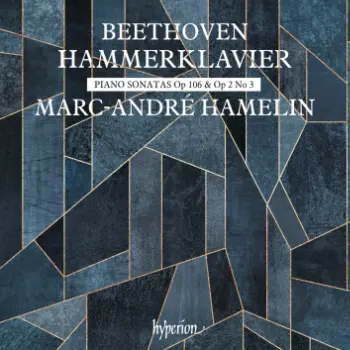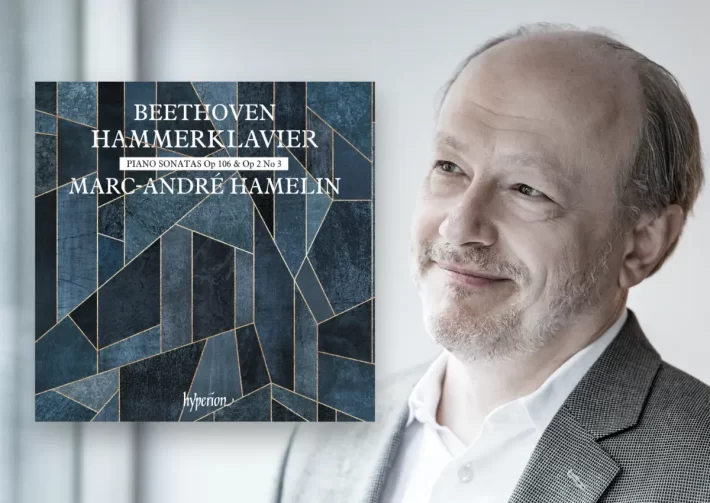With a sonata as epic as Beethoven’s Hammerklavier, Marc-André Hamelin’s complementary pairing with an early sonata, Op. 2 No. 3, is quite sensible. The heft of tackling such a large work like the Op. 106 carries with it additional challenges in the presence of fierce competition: the landmarks from Emil Gilels and Svaitoslav Richter come to mind, but there are also other fine recent renditions from Murray Perahia, Pierre-Laurent Aimard and Beatrice Rana.
Going by the most spirited moments of the Allegro (track 1), Hamelin takes the Hammerklavier moniker quite literally. For the most part this is a good thing, as the chords are resplendently symphonic and nicely voiced. Where some other performances sacrifice the melody for sonoric volume, Hamelin’s puts ample emphasis on the top lines for good continuity. Though at time, the accents and sforzandos are so enthusiastically executed as to sound brash and jarring.
Part of what makes for a good interpretation is a performer’s ability to bring a sense of balance to the movement, via the less charged episodes. Beethoven indeed intersperses intricate passages throughout the movement: Hamelin plays them with great clarity, yet the passagework is on the crystalline side. Turn to Beatrice Rana’s recording (reviewed here) and we hear a little more warmth in her legatos, which in turn creates velvety, charming moments of respite.
Hamelin takes a fairly square, rhythmic approach to the Scherzo, and while there’s nothing particularly wrong with executing the dotted rhythms down to a T, the interpretation could use more imagination. As the title of the movement suggests, some humor should be involved, and Murray Perahia’s (DG) truly brings this spirit to life. His tempo pushes forward just a little more to create playful insistence, and the outbursts of forte add a boisterous character that’s hard to resist.
The Allegro sostenuto (track 3) is what brings Beethoven’s quintessential element of pathos to the work. Hamelin’s playing is indeed beautiful at first listen: the hymnal textures of the chords and the lyricism are there. However, I was missing a sense of profundity. One driving factor is the striking key changes, like the one at 1’09”: Hamelin doesn’t capitalize enough on this magical moment to create the contrast of mood, and so we have more or less a continuation of the same, lovely but not arresting playing.
One of the recordings that manages to capture these elements is Gilels’: the tempo he takes is just right, allowing each chord to sink in fully but not at the cost of the melody’s fluidity. The depth and weight of his tone, too, is something that few other recordings have emulated. The result of this deeply mindful playing is an interpretation that brings out the emotional interplay between despair and catharsis.
Join The Classical Newsletter
Get weekly updates from The Classic Review delivered straight to your inbox.
The final movement like the others, is well executed yet lacks an extra “oomph”. The introductory Largo section, in particular, could assume a more anticipatory character as a buildup to the sprawling Fugue, but I found myself drifting at times—something I did not encounter in Sviatoslav Richter’s rendition, which better manages nuanced dynamic shadings and suspenseful phrasing. The fugue itself, however, is well played, with all the details of the contrapuntal lines coming through lucidly.
In the early Piano Sonata Op. 2 No. 3, Hamelin plays with fitting joviality and energy. Yet given the more classical idiom of this work, he could use a lighter hand in certain spots, which tend to sound too similar in intensity to the Hammerklavier.
Hamelin’s performances across the board are no doubt solid, showing familiarity and facility with the demand of each work. However, there is more potential to be offered musically to make this album stand out. My primary recommendations therefore remain unchanged.

Recommended Comparisons (Hammerklavier):
Gilels | Perahia | Rana | Richter | Brendel
Beethoven – Piano Sonatas
No. 3, Op. 2 No. 3
No. 29, Op. 106, “Hammerklavier”
Marc-André Hamelin – Piano

Check offers of this album on Amazon Music.
Album Details |
|
|---|---|
| Album name | Beethoven Hammerklavier |
| Label | Hyperion |
| Catalogue No. | CDA68456 |
| Amazon Music link | Stream here |
| Apple Music link | Stream here |

















